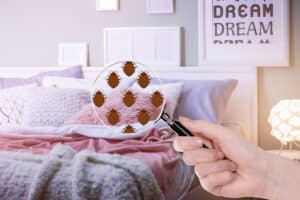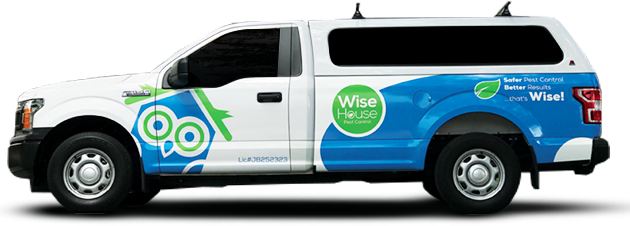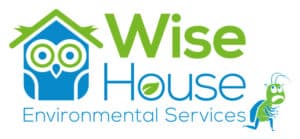South Florida’s warm and humid climate, coupled with its status as a popular tourist destination, has unfortunately created a perfect breeding ground for bed bugs in the state. The increasing prevalence of these resilient pests has become a growing concern for residents, businesses, and the tourism industry alike. Recent statistics indicate that bed bug infestations have been steadily increasing, with Florida ranking among the top 10 states for bed bug problems.
In fact, a study by the National Pest Management Association (NPMA) found that over 80% of pest control professionals reported treating bed bugs in Florida within the past year. In this post we provide information on bed bugs in South Florida, covering their identification, behavior, prevention, and treatment options to help residents and visitors stay informed and protected.

Bed bugs, infamous for their stealthy nature and irritating bites, are a common pest problem plaguing residents of South Florida. These nocturnal creatures, scientifically known as Cimex lectularius, are masters of disguise, making their detection and eradication a challenging task.
Bed bugs are small, oval-shaped insects, typically about the size of an apple seed. Their flattened bodies allow them to squeeze into tight spaces, making them adept at hiding in the seams of mattresses, cracks in bed frames, and even behind wallpaper. Their reddish-brown coloration further aids in their camouflage, making them difficult to spot on various surfaces.
These elusive pests prefer to reside in close proximity to their food source – human blood. As such, they are most commonly found in beds, mattresses, box springs, headboards, and other furniture near sleeping areas. However, they can also infest sofas, chairs, and even luggage, allowing them to hitchhike and spread to new locations.
While bed bugs do not transmit diseases, their bites can cause significant discomfort and distress. Their saliva contains an anesthetic and an anticoagulant, which allows them to feed on their hosts without being detected. Bed bug bites often appear as small, red, itchy bumps on the skin, and they can occur in clusters or lines.
Bite Marks on Skin – Bed bug bites usually result in small, red, itchy welts that appear in a straight line or clustered pattern. They are typically found on exposed skin areas such as the face, neck, arms, and legs. The bites often become inflamed and itchy due to an allergic reaction to the bed bugs’ saliva. Scratching the bites can lead to secondary infections.
Blood Stains on Sheets – Small, rusty-colored blood spots on your sheets, pillowcases, or mattresses are a common sign of bed bugs. These blood stains are typically the result of bed bugs being crushed while feeding. They are often found near the corners and edges of mattresses and bedding. The presence of these stains indicates that bed bugs are active and feeding in your sleeping area.
Dark or Rusty Spots on Bedding and Mattresses – Fecal spots left by bed bugs appear as dark or rusty-colored specks on sheets, mattresses, bed frames, and nearby furniture. These spots are actually digested blood that bed bugs excrete after feeding. They can be found in clusters, often in hidden areas where bed bugs congregate. Fecal spots are a reliable indicator of an active infestation and can help locate bed bug hiding places.
Musty Odor – A strong, musty odor in the room, often compared to the smell of coriander, can indicate a large bed bug infestation. This odor is produced by the scent glands of bed bugs and becomes more noticeable as the infestation grows. The smell can be particularly strong in areas where bed bugs are concentrated, such as behind headboards, inside box springs, and in the seams of mattresses.
Shed Skins – Bed bugs molt as they grow, leaving behind shed skins that are translucent and can be found in areas where bed bugs hide. These shed skins, also known as exoskeletons, are left behind as bed bugs progress through their five nymphal stages before reaching adulthood. Finding shed skins is a sign of an active and growing infestation.
Bed Bug Eggs and Eggshells – Tiny, white, oval eggs and eggshells, about 1mm in size, can be found in cracks, crevices, and other hidden areas. Female bed bugs lay eggs in secluded places, often gluing them to surfaces. The eggs are pearly white and hard to see with the naked eye, but they can be found with careful inspection. Empty eggshells left behind after hatching are also a sign of an ongoing infestation.
Nymphs (Young Bed Bugs) – Bed bug nymphs are smaller and lighter in color compared to adults and can often be seen moving in and out of hiding places. Nymphs are translucent or pale in color and become darker as they mature. They go through several molts before reaching adulthood, requiring blood meals at each stage. Their presence, along with adults and eggs, confirms an active breeding population.
Increased Itching and Allergic Reactions – Persistent itching and allergic reactions, such as rashes and hives, can be caused by bed bug bites and indicate their presence. Some people may experience more severe reactions to bed bug bites, including blister-like welts and intense itching. Reactions can vary based on individual sensitivity and frequency of bites. If unexplained itching or skin reactions occur, it’s important to inspect your sleeping area for bed bugs.
Increased Activity at Night – Bed bugs are nocturnal and are most active at night. If you notice more bites or activity during nighttime, it’s a sign of an infestation. Bed bugs typically feed just before dawn when hosts are in deep sleep. If you notice bite marks appearing overnight or spot live bed bugs during nighttime inspections, it’s a strong indicator of their presence.
Pet Discomfort – Pets may also be affected by bed bugs, showing signs of discomfort, itching, or bites. Bed bugs can bite pets, leading to similar reactions as seen in humans, such as itching and irritation. If your pets are restless and exhibit signs of bites, it’s important to check their bedding and sleeping areas for bed bugs.
Hiring a professional pest control service is one of the most effective ways to eliminate bed bugs and strongly advised by many. Professionals have access to specialized tools and treatments that are unavailable to the general public. They can conduct thorough inspections, identify all infested areas, and apply targeted treatments to ensure complete eradication. Many services offer follow-up visits to ensure the infestation is fully resolved.
Heat treatment involves raising the temperature in the infested area to a level that is lethal to bed bugs. Bed bugs and their eggs cannot survive at temperatures above 120°F (49°C) for extended periods. Professional heat treatment involves using specialized equipment to uniformly heat the affected space. This method is highly effective because it can penetrate into cracks and crevices where bed bugs hide. Ensure the treatment is done by professionals to avoid damage to belongings.
Regular and thorough vacuuming can help remove bed bugs and their eggs from surfaces. Use a vacuum with a HEPA filter to vacuum all infested areas, including mattresses, bed frames, carpets, and furniture. Pay special attention to seams, folds, and crevices. After vacuuming, immediately seal the vacuum bag in a plastic bag and dispose of it in an outdoor trash bin to prevent bed bugs from escaping. While vacuuming alone may not eliminate an infestation, it can significantly reduce the number of bed bugs.
Encasements are protective covers for mattresses and box springs that trap bed bugs inside and prevent new infestations. Purchase high-quality, bed bug-proof encasements for your mattress and box spring. These encasements should be tightly woven and have a secure zipper to prevent bed bugs from entering or escaping. Encasements can help isolate bed bugs already in your mattress and prevent them from biting. Additionally, they make it easier to detect and treat new infestations.
Steam cleaning uses high temperatures to kill bed bugs on contact. Steam cleaners effectively reach bed bugs hiding in hard-to-reach places, such as mattress seams, furniture crevices, and baseboards. Use a steam cleaner with a high-temperature setting (at least 200°F or 93°C) and slowly apply steam to infested areas. Be cautious with steam on certain materials that may be sensitive to heat and moisture. Steam cleaning is a chemical-free method that can be combined with other treatments for best results.
Combining these methods increases the likelihood of completely eliminating bed bugs from your home. For professional help and tailored solutions, you should always contact a licensed pest control professional.
While bed bugs are not known to transmit diseases, their bites can cause itching, allergic reactions, and in some cases, secondary infections from excessive scratching.
Bed bugs leave specific signs like blood spots on sheets, dark fecal spots, and a musty odor. If you’re unsure, contact Wise House Environmental Services at 561-727-8239 for a professional inspection.
Bed bugs can survive in cold temperatures for short periods but are most active and reproduce rapidly in warm environments
No, bed bugs do not spread diseases, but their bites can cause discomfort and allergic reactions.
Wash all bedding and clothes in hot water and dry on high heat. Store cleaned items in sealed bags until the infestation is eliminated.
Bed bugs reproduce rapidly and can spread quickly throughout your home. Early detection and prompt treatment by Wise House Environmental Services at 561-727-8239 are crucial to control the infestation.
Depending on the treatment method, you may need to leave your home temporarily. Wise House Environmental Services will provide specific instructions to ensure your safety.
The duration varies based on the severity of the infestation and treatment method. Typically, multiple treatments over a few weeks are necessary.

Ready to send away pests without harming your pets? Getting started with Wise House Environmental Services is as easy as 1-2-3:
With Wise House Environmental Services, you get more than just effective pest control; you get peace of mind, knowing that your home is without pests and safer for your pets.
Our approach to pest control combines science with safety, offering you the kind of targeted, effective solutions that you won’t find with just any other pest control service. Our services have made a world of difference for homeowners, and we can do the same for you. Your pets will thank you for it!
We serve Port St. Lucie,Lake Worth, Boyton Beach, Palm Beachand the Treasure Coast.


© 2023 All Rights Reserved. | Sitemap